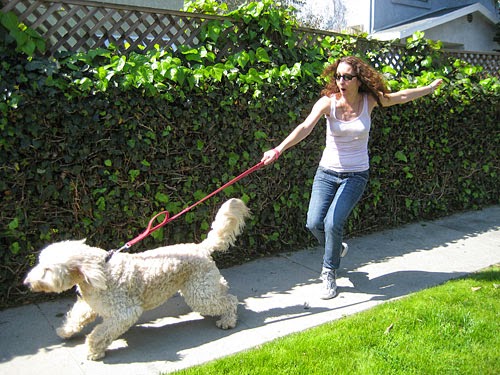It is not enjoyable to take a dog for a walk that pulls on the leash. Furthermore, your friends and family don’t particularly want to help care for your dog when you are away because he or she is hard to handle. It’s also unpleasant for your groomer, boarding kennel, and veterinarian. In this instance, I am of the opinion that it is not sufficient to reach a tolerable state with your dog, but rather get your pet behaving as others would expect him/her to.
 |
| http://blog.adoptandshop.org/bad-habits-leash-pulling/ |
(When I refer to a tolerable state, that is when you have accepted your pet to perform a command sub-par because you are satisfied with that level of response. Example: you tell your dog to sit and stay, which he does for 5 seconds, then he stands up. This is a sub-par response because optimally when you tell your dog to sit and stay he should remain in a sit/stay as long as it takes until he is released from that position.)
Why does my dog pull? In most cases, it is because your dog learned that when he saw something interesting and pulled in that direction, you followed. When walking down the street if he pulls forward you will respond by walking faster.
Why doesn’t he stop pulling when I tell him to? Your dog has months or years of being rewarded for pulling (by getting to where he wants to go faster), so why should he listen now? Why should he listen when you only ask him to not pull 30% of the time? It usually pays off to pull, so he’ll keep it up.
A tight leash is a conditioned response – your dog can become accustomed to the pressure and learn to not mind it one bit. You must teach your dog to walk without pressure on the leash.
Are you ready for the magic? Here it is…
You must teach your dog to walk on the leash by not trying to walk anywhere at all. In other words, you need to get the thought of going down the street, around the block, or along the woodsy path out of you head. When training leash walking, you have to be satisfied going nowhere in particular.
Once you have embraced this concept, here is what you must do.
When your dog pulls on the leash either: 1. Stop walking or 2. Go the opposite direction
You can say, “no pull†if you wish, but you may start to sound like a broken record. You can choose to say nothing, or you can make some other noise like “Ah!†to indicate you aren’t happy.
When your dog is walking along with you, be sure to tell him “good!†or “yes!†and occasionally give treats.
Eventually, you will be able to pick the direction you walk in and your dog will walk along side you.
Be sure to use this tactic for walking EVERY time. You can never let your dog pull on the leash, so if you have somewhere to go, I suggest you carry him there if you can’t take the time to train on the way.
Happy training!
Dr. Amy Hellard
West Chester Veterinary Care







